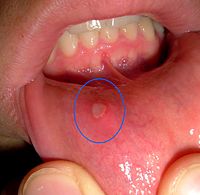
Photo from wikipedia
OBJECTIVES Dental anxiety is ultimately related to the fear of pain, more evidently seen in surgical dental procedures. This study aimed at comparing the stress parameter differences between patients undergoing… Click to show full abstract
OBJECTIVES Dental anxiety is ultimately related to the fear of pain, more evidently seen in surgical dental procedures. This study aimed at comparing the stress parameter differences between patients undergoing minor oral surgery (MOS) with their eyes covered (closed) versus uncovered (open) at our center. MATERIALS AND METHODS Twenty-three MOS patients were draped with eyes covered, while another 23 MOS patients were draped with eyes uncovered. Stress parameters such as systolic and diastolic blood pressures (DBP), mean arterial pressure (MAP), heart rate, random blood glucose, and Spielberger State-Trait Anxiety Inventory (STAI)-6 questionnaire score were recorded accordingly in the different intervals; then statistically analyzed later. RESULTS Closed eyes patients had significantly lower mean DBP and MAP (73.91 ± 6.80/88.94 ± 6.88 mm Hg) as compared with open eyes patients intraoperatively. Though significant only in the postoperative phase, the closed eyes group had a relatively lower mean heart pulse rate than the open eyes group in all surgical intervals. Postoperatively, closed eyes patients had lower mean blood glucose level as compared with open eyes group. STAI mean score revealed a higher psychological stress for closed eyes patients versus open eyes patients. CONCLUSION Closed eyes patients displayed lower quantifiable physiological stress level as compared with patients undergoing MOS draped with eyes uncovered. However, in qualitative psychological context, closed eyes draped MOS patients responded poorly as compared with opened eyes draped patients under similar surgical stress.
Journal Title: European journal of dentistry
Year Published: 2022
Link to full text (if available)
Share on Social Media: Sign Up to like & get
recommendations!